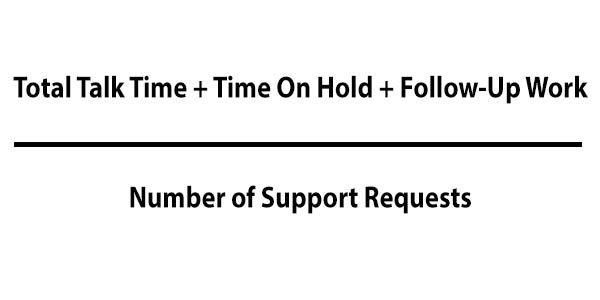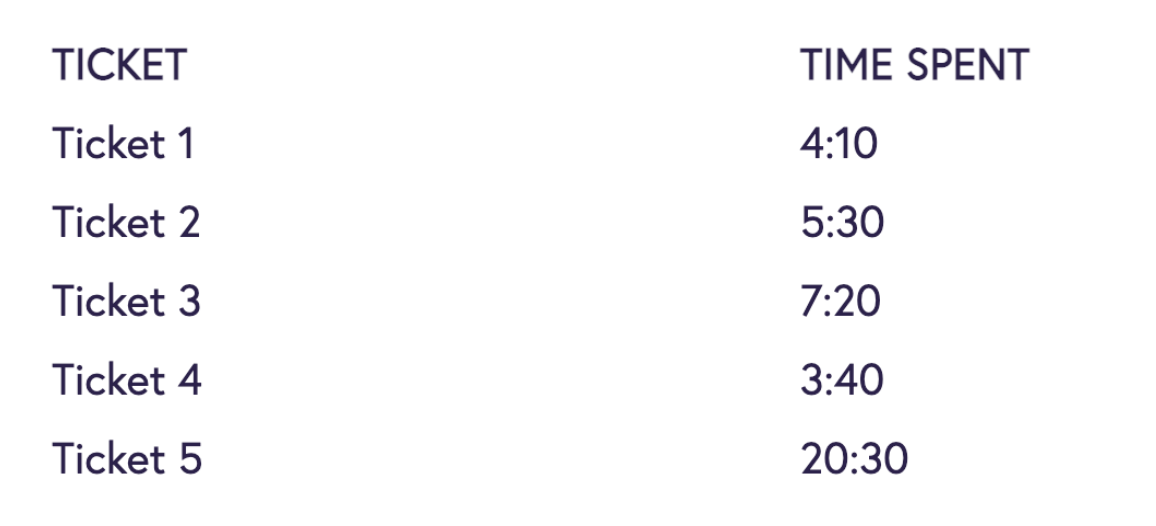
If you’re unfamiliar with Average Handle Time (AHT), then you may not know that it is the average time a support agent or department spends on each customer call or ticket. Not surprisingly, AHT is considered one of the most important customer service metrics because it clearly measures the efficiency and productivity of a support agent or even an entire support team. However, it does come with several notable caveats that you should be aware of before making AHT the end-all-be-all metric for tracking performance. This guide details what Average Handle Time is, how to calculate it and how to reduce it, plus provides important tips and advice for only using AHT in context.
Average Handle Time (AHT) Measures Customer Service Efficiency
Average Handle Time measures how much time customer service spends on each support request, and as the name suggests, as an average. It includes the sum of the time spent communicating directly with customers, which could include researching solutions, placing customers on hold to find a solution, back-and-forth while gathering information, and even follow-up work such as entering notes into helpdesk software.
Generally, a low average handle time means an agent or customer service department is efficient, while a high average handle time means there’s room for improvement. But that’s not always the case because there are instances when a customer support team with a higher AHT will deliver better service than one with a lower AHT, and we’ll show you why later in this guide.
How to Calculate Average Handle Time (AHT)
It’s easy to calculate Average Handle Time with a simple formula:

These monikers can change depending on the channel. For example:
- “Total Talk Time” refers to phone calls, but it’s the same as “Total Response Time” for support tickets and “Total Chat Time” for chats.
- “Time On Hold” is the same as “Time On Research.”
- “Follow-Up Work” is the same as “After Call Work.”
The important thing to note with this equation is that you will always simply divide the total time spent on customer support by the total number of calls or tickets. For example, in a single period of time, an agent might field 75 tickets and spend 300 minutes communicating with customers, 100 minutes on research, and 50 minutes on after-call work. Some of those tickets may have taken an hour or more to solve if the problem was difficult to troubleshoot or if curating the information needed to solve the problem required a lot of back and forth with the customer. Now, when you look at the average then, you would see what the agent’s AHT calculation would look like:

While calculating Average Handle Time is easy, collecting data to make the calculation can prove tedious and error-prone when done manually. That’s because:
- Every agent must track time spent on each ticket, including research time and follow-up work.
- Agents must exclude time they didn’t spend on the ticket, such as breaks or waiting for a customer to reply.
- When a ticket is escalated to another agent, both agents must track time spent on that ticket, then add them together to determine their collective handling time.
- The entire department must track which agent was working on which ticket or a combination of tickets to identify AHT.
Given those complications, accuracy is dubious, and reporting is a nightmare for teams with high ticket volume. That’s why many customer service departments rely on help desk ticketing software to track, calculate and report Average Handle Time automatically. Some help desk software will even allow you to sort tickets by the longest or the shortest and see the ratings for each ticket to see if the time spent on a ticket resulted in a higher rating or not.
A Good Average Handle Time Depends on Multiple Factors
There is no single “good” AHT benchmark. Instead, a good Average Handle Time depends on factors such as department and industry. For example, a company that sells socks can likely resolve most customer service requests faster than a company that sells a SaaS accounting platform. It doesn’t take as long to tell customers which sock sizes are in stock as it does to walk a customer through entering business assets on their dashboard. Similarly, it’s unfair to compare AHT between departments. Shipping support requests might be easier to resolve than billing support requests.
That said, many sources often cite statistics reported by CallCentre Helper’s Erlang Calculator, which helps call centers determine how many agents they need based on anticipated call volume. CallCentre Helper’s data shows that the average AHT among all users is 6 minutes and 10 seconds.
An admittedly-dated yet often-cited 2004 report from Cornell University also states the average handle time across industries as 6:10. Here’s the AHT breakdown by industry, according to the report:
- Business & IT Services: 8.8 minutes
- Large Businesses: 8.7 minutes
- Subcontractors: 6.0 minutes
- Telecommunications: 5.4 minutes
- Financial Services: 4.7 minutes
- Retail: 4.7 minutes
Ultimately, Average Handling Time is relative. A good AHT is just one factor contributing to other, perhaps more critical metrics such as Customer Satisfaction (CSAT) and Net Promoter Score. If customers are frustrated with how long it takes to resolve their issues, lowering AHT is a good customer-focused initiative.
Take Average Handling Time in Context
An Average Handling Time that might be considered good in one industry or department might be regarded as poor in another, so it’s essential to apply context when evaluating AHT. Industry and department aren’t the only contextual considerations, either. Here are four more.
Mean Averages Don’t Always Tell the Whole Story
Consider this example support agent time log:

Given this data set, the standard AHT formula calculates an Average Handling Time of 8 minutes and 14 seconds. But that 20:30 ticket is an outlier inflating the average time the agent spends per ticket, so AHT doesn’t give an accurate picture of agent efficiency or performance. Sometimes, an agent has a challenging call that takes more time than others, and that could be out of the control of the agent, such as if there’s a language barrier with the customer or if the customer is not providing the information needed to solve the problem without having to rephrase the information request multiple times. If this same data set were calculated to the median average, it would come to 5 minutes and 30 seconds, which more accurately portrays the time the agent spends on most tickets but also ignores the fact that once in a while there are tickets that will take 4x longer than the average ticket.
Efforts to Reduce AHT Can Increase It, In a Good Way
Companies often create a knowledge base and FAQ page to reduce the Average Handle Time, but those initiatives can also have the opposite effect. When self-service tools solve a portion of customer problems, only those with the most difficult issues contact customer service. Those tickets take longer to resolve, which increases AHT, but that’s not necessarily negative because it also improves the customer experience and likely increases the customer’s satisfaction which can be tracked and monitored through their CSAT and Net Promoter Scores.
A Customer-Oriented Approach Takes More Time
Providing outstanding customer experience pays enormous dividends, which is why more and more companies are adopting a customer-oriented approach. To put the customer first, agents are encouraged to build strong customer relationships. It takes time to ask a customer how their day is going, if they enjoyed their recent vacation, if they were happy with the product or service before their problem arose, and if there is anything the agent can do to improve their experience. All of these interactions are very important to building a rapport and relationship with customers, but will also increase the AHT. This isn’t a bad thing, of course, but it needs to be taken into account to fully understand the relationship between Average Handle Time and customer experience.
Low-AHT Directives Can Diminish the Customer Experience
Conversely, companies that promote low-AHT directives can damage the customer experience. If agents are pressured to close tickets as quickly as possible, they could cut customers short and leave them with unanswered questions. More commonly, a support representative will close a ticket and mark it as solved without even answering the question or taking the time to address the customer’s issue. Having a KPI to reduce the department’s AHT is a goal that many support teams have adopted blindly. If you have never had a ticket closed on you as a customer without the question answered or the problem resolved, then you know how frustrating it can be. That, in turn, ruins the experience and threatens loyalty and retention. This is why it is never recommended to sacrifice quality for a lower AHT.
Benefits of a Low Average Handle Time
Those caveats aside, companies generally want low average handle times. Here are five benefits of a low AHT, provided service quality remains high.
1. Happier Customers
A low AHT means customers get quick, accurate help, leading to greater customer satisfaction. Happy customers are loyal customers, and they’re more likely to reward efficient customer service with word-of-mouth advertising.
2. Greater Efficiency
Low Average Handle Times improve customer service department efficiency. When agents spend less time on each call, ticket, or chat, they can handle more support requests and speed up resolution time. Today’s customers will often pay more for a product or service if they know the support is outstanding, which is often the case with some of the most expensive products and services, as these types of companies stand behind the idea of providing a premium experience for their customers throughout.
3. Lower Costs
Greater efficiency often means lower costs. Reducing AHT decreases the cost per ticket and can also decrease the number of agents needed to operate the customer service department.
4. Market Advantage
Some companies are notorious for long hold times and frustratingly slow support ticket responses. Businesses that boast low Average Handle Times gain a competitive advantage over competitors that do not prioritize this customer-focused approach.
5. Better Bottom Line
Low AHT often means a better customer experience, which ultimately bolsters profits, retention, and loyalty. 60% of Americans do more business with companies that provide good customer service, while 40% stop doing business with companies that have poor customer service.
8 Ways to Reduce Average Handle Time
If you are looking for ways that you can reduce your Average Handle Time, then these ideas could help your organization lower its AHT.
1. Automation
Customer service automation can significantly reduce Average Handle Time without sacrificing quality. The most efficient customer service departments use ticketing software to automatically route tickets to the most appropriate agents, eliminating manual assignment and pairing customers with agents who can help them the fastest.
2. Self-Help Documentation
By providing self-help tools such as knowledge base articles and FAQ pages, you do run the risk of only receiving more complex issues, which may increase AHT, but they can also be a resource for support agents who can quickly and easily provide customers with the answers to their questions. Including a link to a knowledge base article or video that helps walk the customer through solving their problem, it can drastically reduce the time that the agent needs to spend solving the customer’s issue.
3. Canned Responses
Canned responses enable agents to answer frequently asked questions in just a few clicks rather than spend time typing the same routine responses over and again. Pre-vetted canned responses improve accuracy, too, providing better outcomes. Learn more about how to use canned responses.
4. Training
Robust training helps agents increase efficiency and resolve tickets faster without jeopardizing customer service. Internal knowledge bases can be leveraged as onboarding platforms for new agents and continuing education courses for existing reps. Internal or staff knowledge bases and FAQ pages can also lower AHT by giving agents resources they can quickly share with customers and make great reference resources that help representatives answer questions fast. Another idea is to pair underperforming agents with top performers for training.
5. Use Ticketing Software
Helpdesk ticketing software simplifies customer service, giving representatives the tools they need to deliver outstanding support. In addition to automation capabilities, ticketing software centralizes support requests from all communication channels, so agents don’t waste time juggling multiple platforms. The best ticketing software places customer profiles and support histories at agents’ fingertips to instantly bring them up to speed on each customer’s needs. Mojo Helpdesk provides the option to track time spent on tickets by agents, queues, etc. This is a great tool for assessing your own AHT.
6. Request More Information Upfront
Ask customers to include helpful information when submitting support tickets. Use online ticket forms to request usernames, email addresses, and detailed issue explanations. Collecting this information upfront eliminates the need for agents to waste their first response asking for additional details, which increases AHT. As the team becomes more advanced, some of these requests could even be included in an internal knowledge base article or canned response to cut down the AHT even further!
7. Have a Ticket Escalation Policy
Create a ticket escalation policy and make sure agents know when they should transfer tickets to a senior representative. Don’t allow agents to spend a lot of time trying to resolve problems they’re not trained for. The quicker the right agent gets the ticket, the faster it will get resolved.
8. Leverage Analytics
Collect and analyze key customer service metrics (helpdesk software can do this automatically). Identify benchmarks based on current performance, then set goals for reducing AHT. Goals can apply to individual agents and the entire department. Institute the other initiatives listed here, then measure the results. Ideally, CSAT and Net Promoter Scores will increase as AHT decreases.
While Average Handle Time might not seem like an important metric to measure, it is actually a crucial customer service metric, and by taking a closer look at AHT, you may just uncover new ways to improve productivity or improve the customer experience. A good AHT often means improved efficiency, but context is critical to ensure a low AHT doesn’t cause poor support quality; that’s the last thing your company or your customers want to see. We hope you can follow the tips outlined here to reduce AHT the right way for happier customers, reduced costs, and greater profitability.
